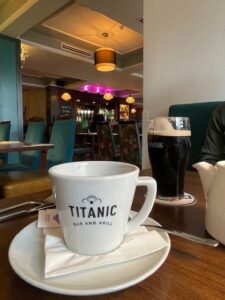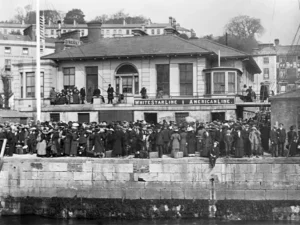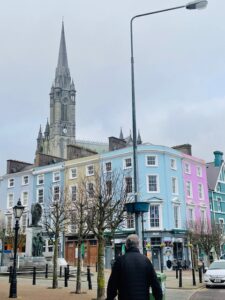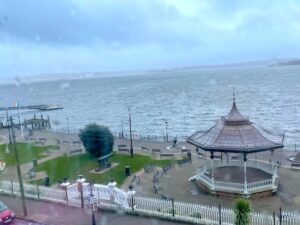Cobh, the saddest city in Ireland
As I’m writing this entry on the morning of March 17,
I can’t help thinking about the two weeks
I spent in Ireland earlier this month. The purpose of the trip was to learn more about HMS Titanic, the subject of my latest novel, Sheltering Angel, based on the true story of my husband’s great-grandparents who were in first class on the ship.
After publishing the novel, I thought I knew all there was to know about the world’s greatest maritime tragedy, but visiting Ireland opened my eyes to much more. Harry and I began in Belfast where the ship was built, but I’ll reserve that experience for another blog. Today my heart leans toward Cobh.
Cobh is a beautiful, colorful town steeped in the history of County Cork.
On the southernmost coast of Ireland, in 1750 the English gave the town the name Cove. The Normans first conquered Ireland in 1169, and the island was considered part of the English imperial system. In fact, Henry VIII named himself king of Ireland in 1541.
When Queen Victoria scheduled a visit to Ireland, before she disembarked at Cove in 1849 the city was renamed Queenstown in her honor, a title it held until 1920 when the Irish won their independence. In 1922, the new government gave the city back its original name, Cobh, honoring their native Gaelic language.
With more than fourteen thousand residents, Cobh has been called “the saddest place in all of Ireland,” and Harry and I felt the heavy pall that hangs over the city. It wasn’t just the cloud cover and the mist that fell on us. The sadness was palpable, a feeling we experienced firsthand.
Known mostly for the mass exodus from Ireland during the 19th Century, Cobh was  the embarkation port of 2.5 million Irish emigrants fleeing famine and poverty between 1848 and 1950. In 1915, the ocean liner RMS Lusitania was carrying 1,959 men, women, and children when the Germans torpedoed the ship killing 1,195 passengers and crew. The 764 survivors were brought to Cobh and probably put up in the same hotel—the Commodore—where Harry and I spent the night. A monument to those lost in the Lusitania disaster stands on a traffic circle in the center of town.
the embarkation port of 2.5 million Irish emigrants fleeing famine and poverty between 1848 and 1950. In 1915, the ocean liner RMS Lusitania was carrying 1,959 men, women, and children when the Germans torpedoed the ship killing 1,195 passengers and crew. The 764 survivors were brought to Cobh and probably put up in the same hotel—the Commodore—where Harry and I spent the night. A monument to those lost in the Lusitania disaster stands on a traffic circle in the center of town.
But we were there because Cobh was of the last port of call before Titanic started its fateful voyage across the North Atlantic. In Belfast we were impressed and moved by the exhibits at the Titanic Museum there. I wanted to see the smaller Titanic Museum in Cobh, one of our last stops before we headed back to Dublin for our homeward flight.
Cobh’s downtown is on the waterfront where the business buildings are painted bright colors. Throughout Ireland, houses along water are painted orange, pink, and bright blue to help guide ships through fog into the harbors. We were lucky to find a parking space for our rental car near the Titanic Museum. Even in the off season, we had a wait before we could take the tour. While we waited, we wandered through the nearby waterfront park named for late U.S. President John F. Kennedy.
When our time came, we climbed a short flight of stairs and walked through the very doors through which Ireland’s Titanic passengers had entered. Then a guide led us to a balcony that ran the length of the building. There we stood where first and second-class passengers waited to board the tenders, PS Ireland and PS America, that would take them out to the big ship anchored behind a small island in the River Lee’s deeper water. Third-class passengers would have crowded the landing below us while they waited for the tenders to unload seven passengers who would not be taking the cross-Atlantic voyage. Within four days, those seven would realize how lucky they were to have ended their short sail in Cobh.
In all, 123 Irish passengers boarded the tenders, 63 men and 60 women. Many of them had scrimped, saved, and borrowed to pay the fare, probably promising repayment after making their fortune in America. For most of them, Queenstown was the gateway to a great new world, beginning in the glamorous city of New York.
It’s not surprising that if you ask any Cobh locals about paranormal activity, they’ll tell you about apparitions they’ve seen by the quayside and point you to old buildings that are undoubtedly haunted. Of the Irish aboard Titanic, 110 lost their lives and a mere 54 survived. It would not be surprising that their spirits lingered in the city where they last stood on land.




Fascinating blog post, Louella. Did you ask at the front desk if guests ever reported moans or other unexplained noises? Thank you for posting photos while on your recent trip. The gorgeous landscapes have made me want to visit Ireland!
Great read .my father is a Cork man .my great uncle Martin mcmahon was 3rd class passenger my nana brother..also my sister Colleen Anderson inheritance some pieces of China with titanic pattern from her husband great grandfather who worked for white star company. Its now on loan to Belfast museum. My nan and great uncle were from Co clare her name was Bridget mcmahon.